Installing cork boards for the sound insulation of interior walls
| 20 June 2010 - Comments (1) | Construction |
 Cork is a fantastic material for both sound and thermal insulation. It is ecological, all natural and reusable. If it is quite expensive to use it for thermal insulation, industrial cork boards can be a viable alternative for sound insulation. The fact that it can be glued directly on brick walls makes it a compelling solution compared to mineral wool. It is thinner and can be cheaper.
Cork is a fantastic material for both sound and thermal insulation. It is ecological, all natural and reusable. If it is quite expensive to use it for thermal insulation, industrial cork boards can be a viable alternative for sound insulation. The fact that it can be glued directly on brick walls makes it a compelling solution compared to mineral wool. It is thinner and can be cheaper.
Measurement of the sound insulation of walls
For interior walls separating apartments, the Weighted Sound Reduction Index (Rw) is the main parameter determining the acoustic comfort provided by the wall. It is expressed in decibel (dB) and give the attenuation of the noise by the wall. That attenuation is the difference in decibels from the source of the noise to the reception on the other side of the wall.
For instance, a vacuum cleaner emitting a noise of 70dB would be heard at 20dB (very light noise) through a wall with a Rw of 50dB.
In most countries, regulations exist to set the Weighted Sound Reduction Index of a common wall between 2 apartments. The value is usually set from 50 to 60dB.
Sound insulation of brick walls
Interior walls separating apartments in Serbian buildings are most commonly built with gitter blocks (the standard Serbian hollow brick). That makes them 19cm thick before coating. In our buildings, we use Klimabloc 25 which is 25cm thick. They are then coated on both sides with mortar and possibly plaster.
Depending of its application and configuration, a brick wall of 25cm coated on 2 sides can theoretically provide a Rw of 50dB. In practice, the number obtained is in the range of 40 to 45dB which is insufficient (see Building Regeneration from Acoustic Points of View from Pavel Oravec).
For a wall made of standard Serbian hollow bricks (19cm thick), the Rw obtained would likely be even below 40dB.
So, in this configuration, the only way to provide real comfort is to place sound insulation on one or both sides of the wall.
Solutions to improve the Rw of brick walls
One solution is to use mineral wool, if possible certified for that type of use, on one side of the wall with aluminum profile and gyps board. The thinest variant is to use 5cm thick profiles and 1.2cm thick gyps boards resulting in 6.2cm. The problem with this solution is the loss of space on one side, the fact that the wall on that side is made of hollow gyps causing problem to fix anything in the wall, it introduces mineral wool inside the apartment and above all, it needs to be done very well to be efficient.
Another interesting solution is to use industrial cork boards. They exist in several thicknesses, from 1cm to 5cm. In the thickness of 2cm, they present a very good price/performance ratio. They can be applied on both sides of the wall to provide superior sound insulation or on one side. Even on one side, the Rw of the wall improves significantly.
This solution is excellent because the loss of space is minimal: only 2.5cm for one side (counting construction glue 0.5cm). If put on both sides, it splits the loss of space between each apartment. Furthermore, cork is completely natural and does not pose any problem of fixation on the wall as it is simple to go though the cork.
For all those reasons, this is the solution than we retained for Amadeo II. In the rest of this article, we go through the steps to install cork board on the walls.
Gluing cork boards on the wall
Applying cork boards on the wall is simple. Construction glue is applied on one side of one cork board which is then positioned on the wall. One board is 1 meter by 50 cm.
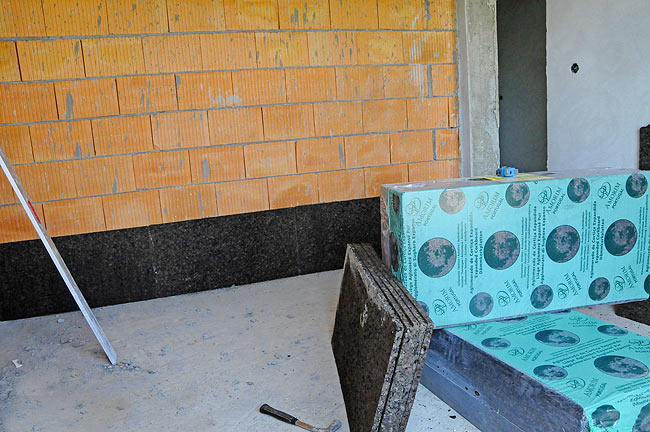
Starting installation of Armorim cork board in Amadeo II.
Cork boards we use are 2 cm thick. With the glue, the thickness stays below 2.5cm which is not so significant on the wall and yet has a good effect of noise reduction.
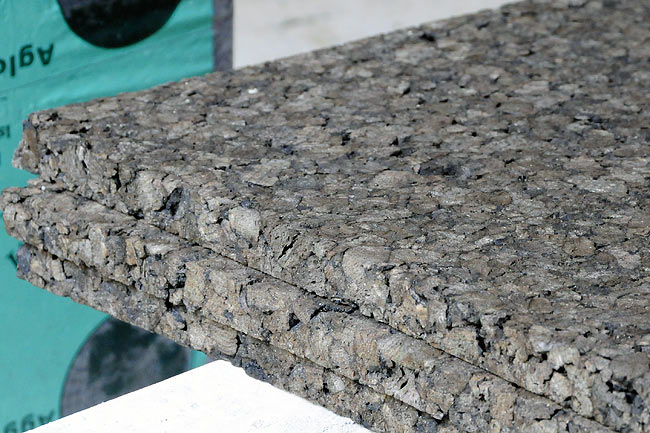
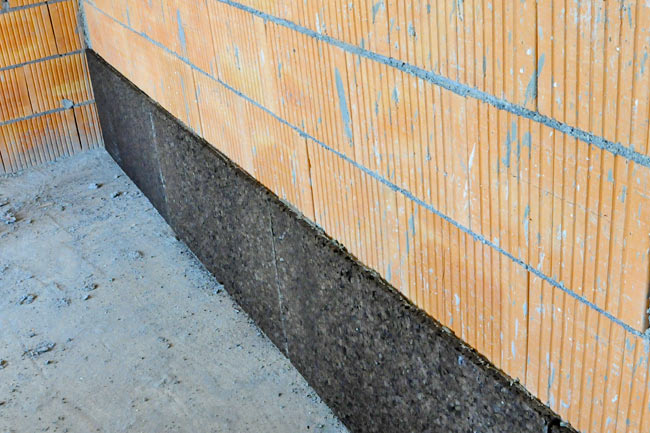
We use Armorim industrial cork board 2cm thick.
Cork is very easy to cut with a simple cutter. As it is all natural there is no special care to take. It actually smells nice once it is put on the walls.


Walls covered with industrial cork board 2cm.
Coating
Once one wall is covered with the cork boards, a first layer of construction glue is passed and, while the glue is still fresh, a standard reinforcement fiber net is applied. The best is to go by slices the same width as the net.
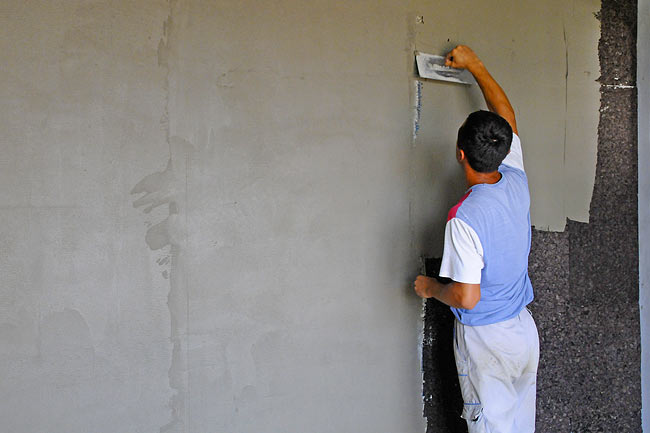
Applying the first layer of glue directly on the cork boards for one slice. The ones before have already been passed with the net.

Applying the reinforcement net on top of the first layer of glue.
Once the reinforcement net is in place, a second layer of construction glue is applied.

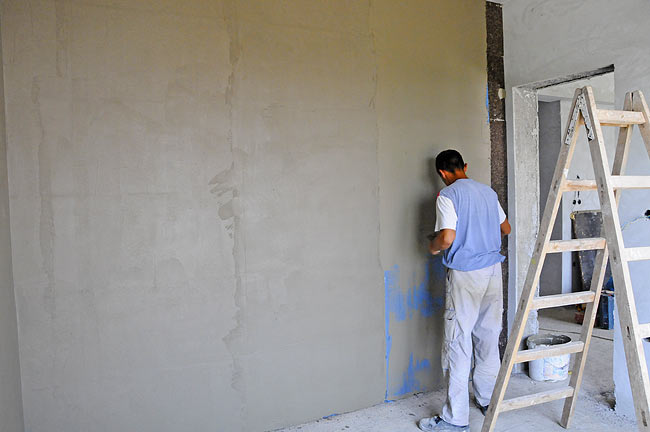
Applying the second layer of construction glue on top of the reinforcement net.
Finish
After the second layer of construction glue, we pass a third one to make the wall ready to be painted. Depending of the finish layer it may be possible to apply it directly on the second layer of construction glue.
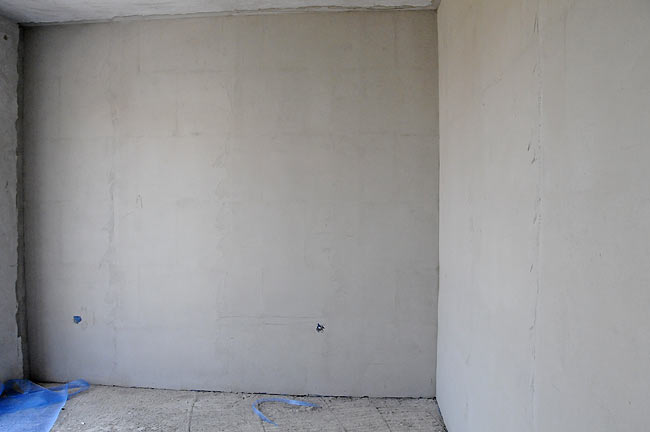
Walls once finished with the 3 layers of construction glue.






































05/07/2010
A.MITCHELL
1
ARMORIM INDUSTRIAL CORK BOARDS